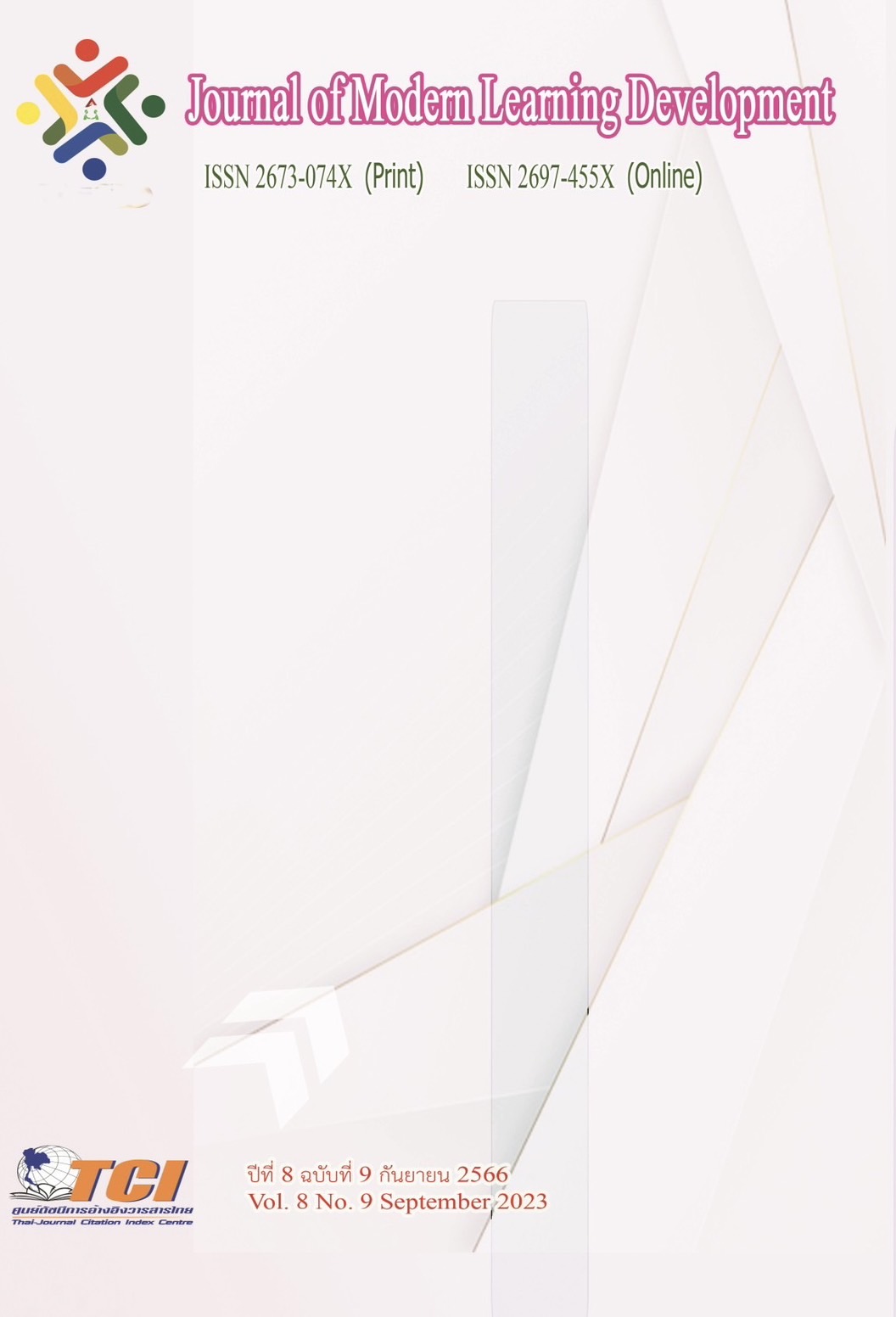Development Model for Characteristics of 21st Century School Administrators in School Under the Secondary Educational Service Area Office Roi-et
Main Article Content
Abstract
The objectives of this research were to: 1) Study the components and indicator of characteristics of 21st century school administrators 2) Study of the current state, desirable state, priority needs index of characteristics of 21st century school administrators in school under the secondary educational service area office Roi-et 3) Create and develop the development model for characteristics of 21st century school administrators in school under the secondary educational service area office Roi-et. 4) Study the results of the experimental the development model for characteristics of 21st century school administrators in school under the secondary educational service area office Roi-et. The research was divided into four phases as follow; phase 1; Study the components and indicator of characteristics of 21st century school administrators, The target group were 5 experts for confirm components and indicator. phase 2; Study of the current state, desirable state, priority needs index of characteristics of 21st century school administrators. The sample group, consisted 296 administrators and teachers. The research instrument was questionnaire and the data was analyzed using mean, standard deviation phase 3; Create and develop the development model for characteristics of 21st century school administrators, The target group were 14 experts for create model by focus group discussion and 9 experts for confirm and evaluation form of propriety, feasibility, and utility of the model connoisseurship. phase 4; Study the results of the model implementation. The target group of 61 school administrators under the secondary educational service area office Roi-et
The results found that:
1. The components and indicator of characteristics of 21st century school administrators was 4 component 42 indicator, Include 1) Technology skill, 12 indicator 2) Communication, 9 indicator 3) Creative thinking /Innovation develop, 6 indicator 4) Visionary, 6 indicator 5) Collaboration, 9 indicator.
2. The current state in overall was high average and the desirable state in overall was in the highest level. The priority needs index from high to low level was 1) Creative thinking /Innovation develop 2) Collaboration 3) Visionary 4) Technology skill 5) Communication.
3. The component of model, Include 1) principles 2) objectives, 3) content 4) development process 5) measurement and evaluation. The result of evaluation for propriety, feasibility and utility was the highest in overall.
4. The results of the model implementation, Overall, the average of the practice that follow the model were at the highest level, the average of module the practice from high to low level was 1) Communication 2) Technology skill 3) Collaboration 4) Creative thinking /Innovation develop 5) Visionary.
Article Details
References
ขัตติยา ด้วงสำราญ. (2552). รูปแบบการบริหารเชิงกลยุทธ์สำหรับโรงเรียนขนาดเล็ก . นครปฐม: มหาวิทยาลัยศิลปากร.
ชัยยนต์ เพาพาน. (2560). ภาวะผู้นำทางการศึกษาและนวัตกรรมทางการบริหาร: กระบวนทัศน์ใหม่ในศตวรรษที่ 21 ของผู้บริหารสถานศึกษา. กาฬสินธุ์ : คณะครุศาสตร์ มหาวิทยาลัยกาฬสินธุ์.
ชาญชัย อาจินสมาจาร. (2560). การบริหารการศึกษาและทรัพยากรทางการศึกษา. กรุงเทพมหานคร: สถาบันเพื่อความก้าวหน้าทางวิชาการ.
ถวิล อรัญเวศ. (2560). คุณลักษณะของนักบริหารยุคไทยแลนด์ 4.0. ออนไลน์. สืบค้นเมื่อ 22 สิงหาคม2564. แหล่งที่มา: http://www.obec.go.th/news/82582.
ธีระ รุญเจริญ. (2550). การบริหารโรงเรียนยุคปฏิรูปการศึกษา. กรุงเทพมหานคร: ธนาเพรส.
บุญชม ศรีสะอาด. (2556). การวิจัยเบื้องตน. (พิมพครั้งที่ 9). กรงเทพมหานคร: สุวิริยาสาสน.
ปณตนนท์ เถียรประภากุล. (2561). ภาวะผู้นำของผู้บริหารสถานศึกษาในยุคการศึกษา 4.0. วารสารมหาวิทยาลัยศิลปากร. 11 (2), 1
พัฐณสิญ นวโลจิตรัตน์. (2560). รูปแบบการพัฒนาคุณลักษณะผู้นำแบบไทยอันพึงประสงค์ของผู้บริหารสถานศึกษา สังกัดสำนักงานเขตพื้นที่การศึกษามัธยมศึกษา ภาคกลาง. วิทยานิพนธ์พุทธศาสตรดุษฎีบัณฑิต สาขาวิชาพุทธบริหารการศึกษา. พระนครศรีอยุธยา : มหาวิทยาลัยมหาจุฬาลงกรณราชวิทยาลัย.
ไพฑูรย์ สินลารัตน์. (2557). ทักษะแห่งศตวรรษที่ 21 ต้องก้าวให้พ้นกับดักของตะวันตก. กรุงเทพมหานคร: มหาวิทยาลัยธุรกิจวิทยาลัย.
วิโรจน์ สารรัตนะ (2561). ภาวะผู้นำสำหรับศตวรรษที่ 21. วารสารศึกษาศาสตร์ มหาวิทยาลัยนเรศวร. 20 (1), 1
สมาน อัศวภูมิ. (2550). การใช้วิจัยพัฒนารูปแบบในวิทยานิพนธ์ระดับปริญญาเอก. เอกสารประกอบการสอนวิชาสัมมนาการศึกษาระดับปริญญาเอก. หน้า 50-53. อุบลราชธานี: มหาวิทยาลัยราชภัฏอุบลราชธานี.
สิริกร ไชยราช. (2562). การพัฒนารูปแบบการพัฒนาภาวะผู้นำครูในการจัดการเรียนรู้ตามหลักปรัชญาของเศรษฐกิจพอเพียงในโรงเรียนมัธยมศึกษา สังกัดสำนักงานศึกษาธิการภาค 11. วิทยานิพนธ์ครุศาสตรดุษฎีบัณฑิต สาขาวิชาการบริหารการศึกษาและภาวะผู้นำ. บัณฑิตวิทยาลัย: มหาวิทยาลัยราชภัฏสกลนคร.
สุวิมล ว่องวาณิช. (2558). การวิจัยประเมินความต้องการจำเป็น. กรุงเทพมหานคร: สำนักพิมพ์แห่งจุฬาลงกรณ์มหาวิทยาลัย.
สำนักงานเขตพื้นที่การศึกษามัธยมศึกษาร้อยเอ็ด. (2564). แผนปฏิบัติราชการประจำปี 2564. ร้อยเอ็ด : กลุ่มนโยบายและแผน สำนักงานเขตพื้นที่การศึกษามัธยมศึกษามหาสารคาม.
สำนักงานคณะกรรมการการศึกษาขั้นพื้นฐาน. (2562). การพัฒนาข้าราชการครูและบุคลากรทางการศึกษาก่อนแต่งตั้งให้ดำรงตำแหน่งผู้อำนวยการสถานศึกษา. กรุงเทพมหานคร: สำนักพัฒนาระบบบริหารงานบุคคลและนิติการ.
สำนักงานคณะกรรมการการศึกษาขั้นพื้นฐาน. (2564). แนวทางการนิเทศการจัดการเรียนรู้เชิงรุก (Active Learning). กรุงเทพมหานคร: หน่วยศึกษานิเทศก์สำนักงานคณะกรรมการการศึกษาขั้นพื้นฐาน.
สำนักงานเลขาธิการสภาการศึกษา. (2563). กรอบทิศทางแผนการศึกษาแห่งชาติ พ.ศ. 2560-2575. กรุงเทพมหานคร: สำนักงานเลขาธิการสภาการศึกษา.
เสริมศักดิ์ วิสาลาภรณ์. (2550). รายงานการวิจัยสภาพการจัดการศึกษาในจังหวัดชายแดนภาคใต้. กรุงเทพมหานคร: วี.ที.ซีคอมมิวนิเคชั่น.
อรอนงค์ สวัสดิ์บุรี. (2555). พฤติกรรมและการสื่อสารภายในองค์กร. กรุงเทพมหานคร: จุฬาลงกรณ์มหาวิทยาลัย.
Anderson, T. P. (1997). “Using Models of Instruction. In C. R. Dills and A. J. Romiszowski (eds)”. Instructional Development Paradigms. Englewood Cliffs, NJ : Educational Technology Publications.
Eisner, E. (1976). Educational connoisseurship and criticism : Their form and functions in education evaluation. Journal of Aesthetic Education. 39 (2), 192 - 193.
Joyce, B. and Weil, M. and B. Showers. (2011). Models of Teaching. Boston: Allyn and Bacon.
Krejcie, R. V. & Morgan, D. W. (1970). Determining Sample Size for Research Activities. Educational and Psychological Measurement.


